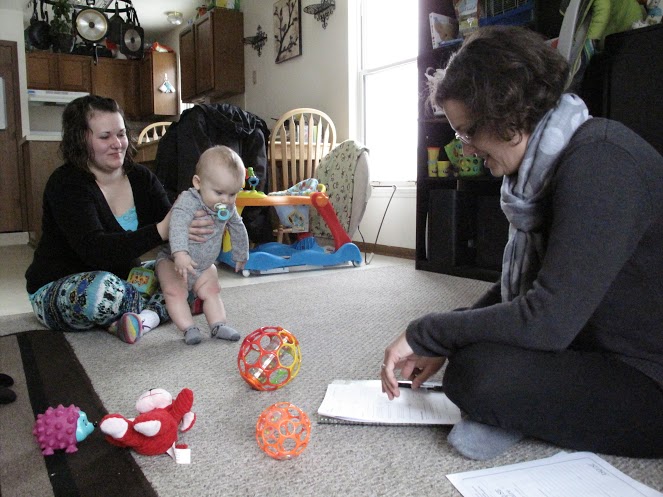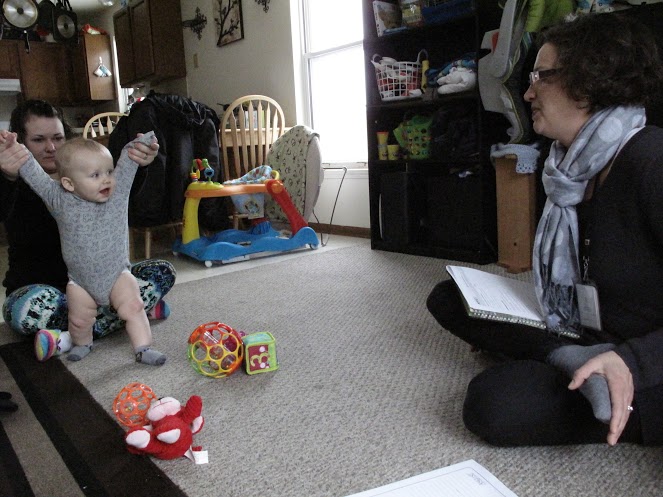Only 1-in-10 at-risk children enrolled in parental coaching program
The young mother greets Becca Boot at her front door like an old family friend.
Boot quickly makes herself at home, sitting on the floor of the small and tidy family room, talking with Melissa Rice, 22, and husband, Jeff, 32, and cooing over Nathan, the couple’s lively 8 month old.
“Look at those fat legs,” Boot says affectionately, as Nathan, with an expressive face and big blue eyes, rolls on the floor, gurgling and reaching for colorful balls.
Though amicable, Boot’s visit to the Rice home, in Standale, outside of Grand Rapids, goes beyond friendship. Boot is a social worker for Catholic Charities of West Michigan, and her outing is part of a voluntary home-visitation program that connects trained professionals with at-risk families.
Nathan is among 25,000 children benefitting from Michigan home-visit programs, which studies show have positive impacts on vulnerable families while producing long-term benefits for states. Unfortunately, a recent analysis indicates that fewer than 1-in-10 at-risk Michigan children are benefiting from home visits.
Data from the Citizens Research Council and Public Sector Consultants, Lansing-based research organizations, show Michigan has about 260,000 children who meet criteria for home visitation, suggesting a vast unmet need.
Expanding the program for these children won’t come cheap, at least initially: Covering all vulnerable children in the state could cost about $5,000 per child on average, according to the CRC-PSC study, which recommends focusing on the state’s neediest children first, which would trim the price tag.
While upfront spending might be steep, research on home visitation programs across the country shows they save state taxpayer money in the long run through reduced payouts on Medicaid, child welfare, criminal justice, special education and other public assistance.
“The research base supporting home visiting is remarkable for its breadth and quality and for the positive results these programs have generated,” the CRC-PSC study noted.
In his proposed budget this year, Gov. Rick Snyder has included $5 million to expand home-visiting programs for at-risk families to encourage early literacy activities and to identify children who need further intervention services.
Research is clear
At the Rice home, everyone quickly gets down to business.
“Should we do some questions about you?” Boot says to Nathan in a playful voice. Turning her attention to Melissa, Boot asks a series of queries to gauge Nathan’s development progress:
“Is he making any high-pitched squeals?”
“Yes,” said Melissa.
“When he’s playing around with sounds, is he grunting or growling?”
“Yes,” Melissa answered, adding: “When he eats he goes, “’Mmmmmm.’”
Boot, one of an estimated 600 home visitation workers in the state, checks a box on her questionnaire.
The conversation and questioning continue for 40 minutes, as Boot and the couple cover such topics as feeding, sleeping, facial expressions, moods and relations with the other children in the home, Leah, 11, and Andreux, 4.
In providing programs to support at-risk children from birth to 3 years old, research shows home-visitation programs are the most effective intervention strategy to help establish healthy, nurturing and stable relationships with parents or adult caregivers, which are considered vital to avoid developmental deficits in children that can have long-lasting effects into adulthood.
Studies have shown, for example, that home-visited mothers with a variety of risk factors subsequently rely on fewer months of government assistance than mothers who do not receive home visits. Moreover, by the age of 6, children in these programs show higher intellectual functioning, better vocabularies and fewer behavioral problems, which lead to better education outcomes for the children, more stability for parents and fewer long-term costs to the state overall.
In a New York study published in 2012, researchers followed up with home-visited children when they were 7 years old and found “significant positive effects on measures related to child maltreatment” and positive academic outcomes. Children were more likely to be participating in gifted programs and less likely to be receiving special education services than children in the control group.
Mothers in the study employed less physical abuse and more non-violent discipline strategies than did mothers in the study’s control group.
The consensus of long-term studies has yielded growing bipartisan support for these parenting programs. For example, U.S. Rep. Paul Ryan, the Wisconsin Republican, and Nicholas Kristoff, the liberal New York Times columnist, have both shown support for home-visiting as an effective tool to fight poverty.
Michael Foley, executive director of the Michigan Children's Trust Fund, a state agency that works to prevent child abuse, said home visitation plays an important role in guaranteeing at-risk children a better chance to have a healthy start to life.
“It provides the basic things that little ones need, this nurturing and attachment, that not only are they not abused, but they are getting what they need to be ready for preschool and to have their infant mental-health issues addressed,” he said.
The CRC-PSC study recommends several steps if state policymakers want to expand home-visitation programs in Michigan:
- Provide grant funding to ensure that a variety of home-visitation models proven to be effective are available so that children with a variety of risk factors can be served. If 5,000 additional children were served, the study says it would cost an estimated $25 million a year.
- Fund technical assistance, such as staffing, for local communities, which would cost less than $1 million a year statewide.
- Prioritize spending so that the neediest children are helped first.
- Help communities do a better job connecting at-risk families with home-visitation programs.
In 2014, home-visiting programs in Michigan received over $30 million in funding ‒ $12.6 million in state funding and $19 million in federal funds ‒ state records show. The prospects for additional funding could be challenging this year, with the legislature dealing with a deficit, according to Lansing observers and state legislators.
Amy Zaagman, executive director of the Michigan Council for Maternal and Child Health, which lobbies for hospitals, public health departments and other healthcare organizations, said home visitation’s complexity makes it tough to understand for both legislators and the public. The term “home visiting” is vague; Zaagman said people sometimes confuse it with home health care for the elderly.
Another stumbling block she encounters is the notion among some people that government-funded workers visiting homes carries the stigma of Big Brother-like intrusion, though virtually all home-visiting programs are voluntary for families.
When people understand home visiting means aid for parents who want help, support is very high, Zaagman said.
“We need some help as far as messaging goes,” she said. “Even with a very conservative audience, I think what a lot of people like is that it’s designed to be a coaching program, helping the parents be better parents.”
A complicated history
The roots of home-visitation programs in Michigan go back 30 years, when the state began creating programs to help at-risk families. As recently as 2012, the state legislature passed a home-visitation measure that bolstered accountability and directed funding to programs with the strongest evidence of success.
Home visitation in Michigan is extremely decentralized: Funding comes from federal, state and private sources, and three state offices – the departments of education, community health and human services – have overseen the programs, though two of the departments are merging into the Department of Health and Human Services.
In Kent County alone, more than 30 organizations offer home-visitation services. And home visit organizations across the state use at least five different home-visitation models on which they base their methodology.
The model followed by Catholic Charities home visitors in Grand Rapids is that of Healthy Families America, a federally-approved program that serves families in 430 communities in 35 states, Washington D.C. and Canada.
Barb Hatkowski, Boot’s supervisor, said Catholic Charities’ home visitation helps an array of parents, from impoverished, single mothers who don’t speak English and were never nurtured themselves as children, to college-educated couples who aren’t sure of their parenting skills.
“If they have support, if any of these families on our spectrum have someone in their corner, it makes such a difference in their life,” Hatkowski said.
“If they have a family support worker, it might be the only person in there saying and telling them accurate information and saying, ‘Ok, you’re doing a great job. Lets try getting down with the baby and doing some tummy time.’”
Helping the Rice family
Melissa Rice, 22, grew up in Grand Rapids and attended some college classes to be a radiology technician. She also has worked at a Meijer’s service desk, though she has been unemployed since Nathan was born. Husband Jeff, 32, works at an automobile oil-change facility.
They were lead to the Catholic Charities home-visiting program – and Boot – though a flyer that came in the mail when their son Andreux was 6 months old, almost four years ago.
She and Jeff qualified for visitation because at the time they were unmarried and Melissa was a teenage parent. They also had limited employment and financial resources, and other programs that Melissa had been utilizing were ending due to the age of the baby at that time.
“You can learn so much from every person, whether they are a mom or not, and that’s all valuable to me,” Melissa said. “I’ve always had the maternal instinct, and my mom taught me well, but you’re still learning.”
One of the issues she and her husband have had to deal with since Nathan’s birth is Andreux’s feelings toward his new brother. “Dealing with a toddler and a newborn is not easy,” she said.
She praises Boot for her refusal to make hasty judgments and her overall skills as a social worker.
“She’s open. She listens. She’s kind of been like a counselor to me, and a good friend. I text her,” Melissa said.
The Rice family has made significant strides in the past few years, but has experienced tensions recently related to Jeff’s former wife and the stepfather of his daughter, Leah.
“There was so much going on and Becca was there the whole dramatic part of it, the court hearings and the cases,” Melissa said. “There’s been a lot going on.”
Making a difference
Boot is a 38-year-old mother of two young children. She sees three to four families a day, and puts in hours two nights a week because she deals with so many working moms. The children she sees range from unborn to 5 years old. About half of her clients are single mothers.
Some of what she does is simply engaging the parents, asking them about their week and their lives.
“I also provide a lot of development stuff: ‘This is what your baby needs from you to be emotionally connected to you,’” she said.
Boot teaches activities to help babies’ fine and gross motor skills and communication, and provides specific activities to get the baby where it should be. She helps connect families with doctors, transportation and baby supplies.
“I go in blind on visits,” Boot said. “You never know what you are going to get into.”
Boot said from the beginning Melissa Rice has been open to suggestions and willing to ask questions, which makes it easy for a home visitor.
“They have had to go through a lot of crap. And they are still surviving and thriving. They were not married when I first met them, and Mel was young – 18, and she became a stepmom to a girl who was not hers. That’s been a challenge. But she shows immense maturity for someone her age.”
As Nathan napped nearby, Boot looked at Melissa and said: “I’m just so proud of you on how you’ve been not only with Leah, but how you’ve been able to maintain with the kids. And then making this place into a home.”
Later, outside, as Boot was leaving and preparing to drive to her next appointment, she considered the meaning of success when there are so many clients, often with profound problems.
She told the parable of the starfish – how a young man came across an older man walking along a beach with tens of thousands of starfish. The old man was throwing the starfish into the sea, one by one, saying if he stopped they will die.
The young man asked if he realized he could not possibly save them all, and that his efforts were not going to make a difference.
The old man listened calmly, Boot said, and then bent down and picked up another starfish and threw it into the sea. “It made a difference to that one,” he said.
Motioning to the Rice home, Boot said: “I know I’ve made a difference to that family.”
Michigan Education Watch
Michigan Education Watch is made possible by generous financial support from:
Subscribe to Michigan Education Watch
See what new members are saying about why they donated to Bridge Michigan:
- “In order for this information to be accurate and unbiased it must be underwritten by its readers, not by special interests.” - Larry S.
- “Not many other media sources report on the topics Bridge does.” - Susan B.
- “Your journalism is outstanding and rare these days.” - Mark S.
If you want to ensure the future of nonpartisan, nonprofit Michigan journalism, please become a member today. You, too, will be asked why you donated and maybe we'll feature your quote next time!


 Nathan Rice, 8 months, can rest assured that his parents are getting support and advice from a Michigan home-visitation worker.
Nathan Rice, 8 months, can rest assured that his parents are getting support and advice from a Michigan home-visitation worker. Becca Boot, a social worker from Catholic Charities of West Michigan, asks questions of young mother Melissa Rice about the development of her son Nathan.
Becca Boot, a social worker from Catholic Charities of West Michigan, asks questions of young mother Melissa Rice about the development of her son Nathan. Nathan Rice, 8 months, is among an estimated 25,000 Michigan children receiving home-visitation services for at-risk families. A new study indicates 260,000 children in the state could benefit from the program.
Nathan Rice, 8 months, is among an estimated 25,000 Michigan children receiving home-visitation services for at-risk families. A new study indicates 260,000 children in the state could benefit from the program.
